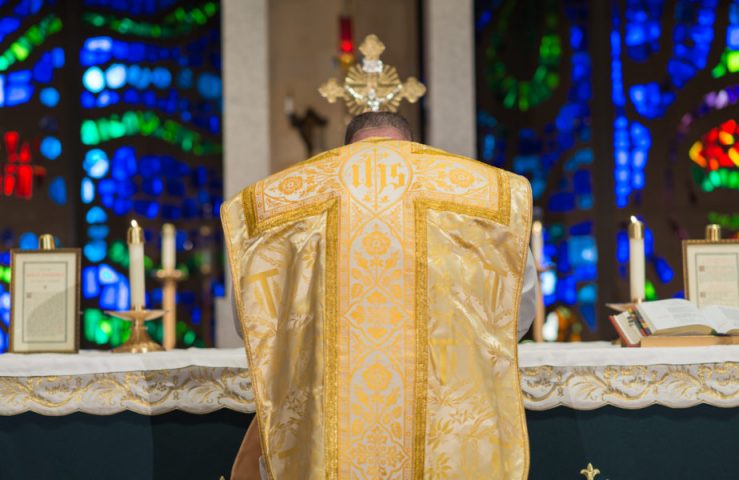 Many Catholics would be skeptical to walk into a Mass that seems straight out of the Middle Ages, a Mass they could barely understand. The stigmas surrounding the “Latin Mass” has led numerous Catholics to question it: If the Church changed it, why go back to the “old ways”? Can I even get anything out of it? Wasn’t it invalidated?
Many Catholics would be skeptical to walk into a Mass that seems straight out of the Middle Ages, a Mass they could barely understand. The stigmas surrounding the “Latin Mass” has led numerous Catholics to question it: If the Church changed it, why go back to the “old ways”? Can I even get anything out of it? Wasn’t it invalidated?
But the Tridentine Mass or the Rite of St. Gregory the Great (names for the “traditional Latin Mass”) isn’t bad at all. In fact, many Catholics have “re-fallen” in love with it – not to mention the many saints it has sustained throughout history. It helps the faithful dive into a journey of the Mystery of the Mass through the silence, richness and beauty it radiates – and the fact that it’s in Latin actually helps.
“It takes most people about five or six times – with someone to show you the ropes – [to be able to follow it]. Then when you can follow it, and it starts to click, you might just fall in love with it, as I did, as do many,” said Father James W. Jackson, pastor at Our Lady of Mount Carmel Parish in Littleton and member of the Priestly Society of Saint Peter. “Even after that, there will remain depth of symbolism you won’t catch.”
Beauty and mystery are two components of this ancient liturgy that attract the many who experience its silence, music and language, Father Jackson said.
“The beauty and mystery of ecclesial Latin is not an obstacle, but a draw for many,” he said, echoing the words of the German theologian Father Matthias Scheeben, who said that for the heart that thirsts for knowledge of truth, the sublime, extraordinary and incomprehensible exercise a special attraction because “a truth that is easily discovered… [cannot] enchant.”
In a similar way, the preferred use of Gregorian chant, Latin and much silence in this liturgy opens the Christian to the mystery taking place.
Its origins
Tridentine Mass is just another term for the Roman Rite that appeared on the Roman Missal from 1570 to 1962. It gets its name from the Council of Trent, which sought to restore the ancient rite practiced in Rome and make it mandatory in the Latin Church. Scholars say this rite, promulgated by Pope Pius V, can be traced back at least to the fourth century, for even Pope St. Gregory the Great (590-604) sought to remove contemporary traditions from it. For this reason, many prefer to associate his name with the rite instead of the council’s. The ancient liturgy is believed to have originated with the Apostle Peter, although it has experienced accretions throughout the ages.
“The beauty and mystery of ecclesial Latin is not an obstacle, but a draw for many.” (Photo by Brandon Young)
After the Second Vatican Council, the Novus Ordo Mass promulgated by Paul VI in 1969 succeeded the Tridentine Mass and is now the Mass that most Catholics are familiar with. One of its greatest changes is a wider use of the vernacular language.
The post-Vatican II change of the liturgy brought about many questions that numerous Catholics still wonder today: What happened to the “old rite”? Is it still valid? Why go back to it?
In 2007, Pope Benedict XVI made it clear that the “new rite” from 1969 did not null the “old rite,” which was last published in 1962. Neither were they two different rites or versions. Instead, they must be seen as a “twofold use” of the same rite.
Thus, he called the “new” rite the “Ordinary Form” and the “old” rite (the 1962 Tridentine Mass) the “Extraordinary Form” of the Roman Rite. He also gave permission to all Latin Rite Catholic priests to celebrate the Extraordinary Form without people and with people “who, of their own will, asked to be admitted.”
People are now rediscovering the richness of the ancient Roman Rite that is, at times, easy to miss in the Ordinary form most Catholics attend in the present day.
“If one wanted to experience the older liturgy, it would have been quite difficult when I first started to say it in 1992,” Father Jackson said. “There were around 20 places in North America where one could attend the older use and be in full union with the local diocese and the Holy See.
“There are now around 475 churches which use it, increasing at a rate of about three new parishes per month. That growth is not phenomenal, but it is significant.”
Deep into the mystery
Some of the biggest visible ways the Extraordinary form differs from the Ordinary form in our time include the wider use of Latin (except for the homily and readings which sometimes are read in both languages), the use of Gregorian chant and polyphony instead of hymnals, the priest and congregation mostly facing the same direction (ad orientem, or to the east, toward the altar), much more silence, communion reception kneeling and on the tongue and more.
NORTHGLENN, CO: Father Joseph Hearty celebrates a traditional Latin Mass at Immaculate Heart of Mary Parish in Northglenn, CO. (Photo by Brandon Young)









